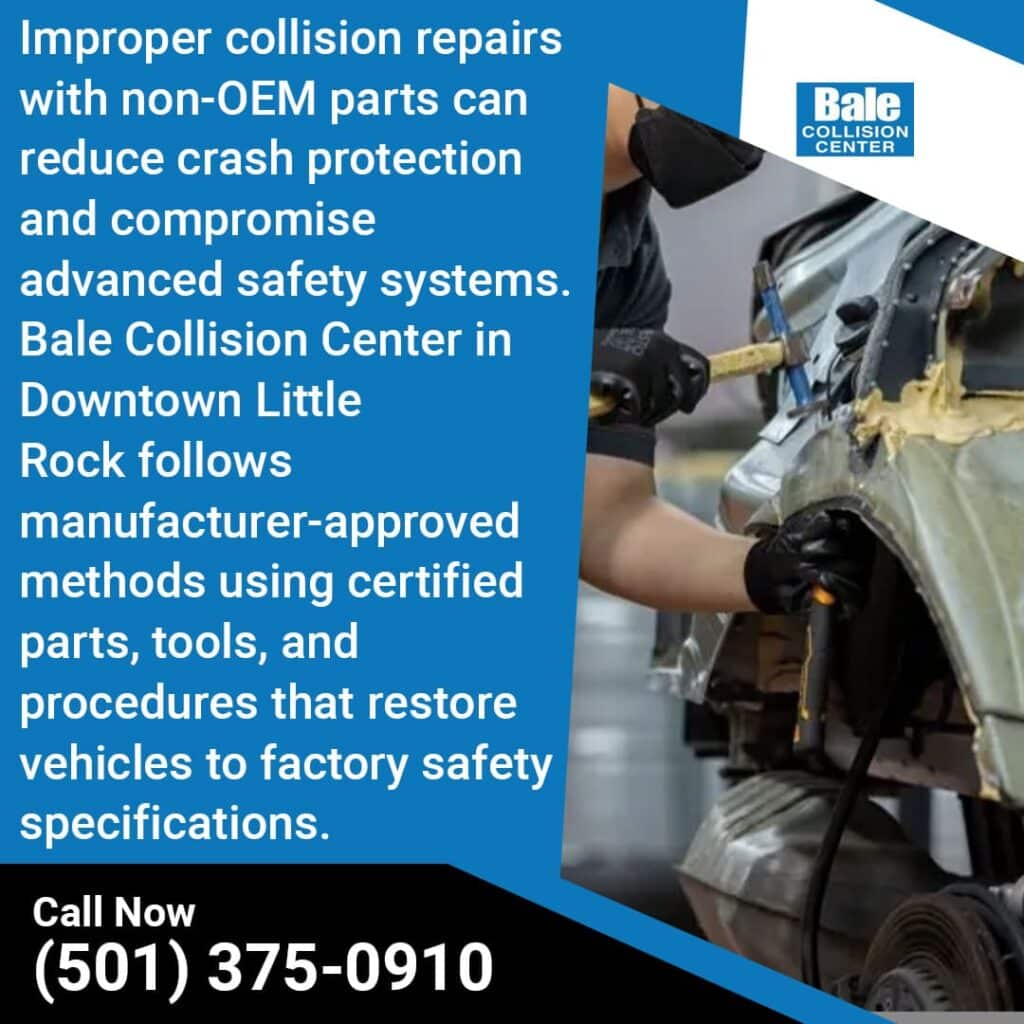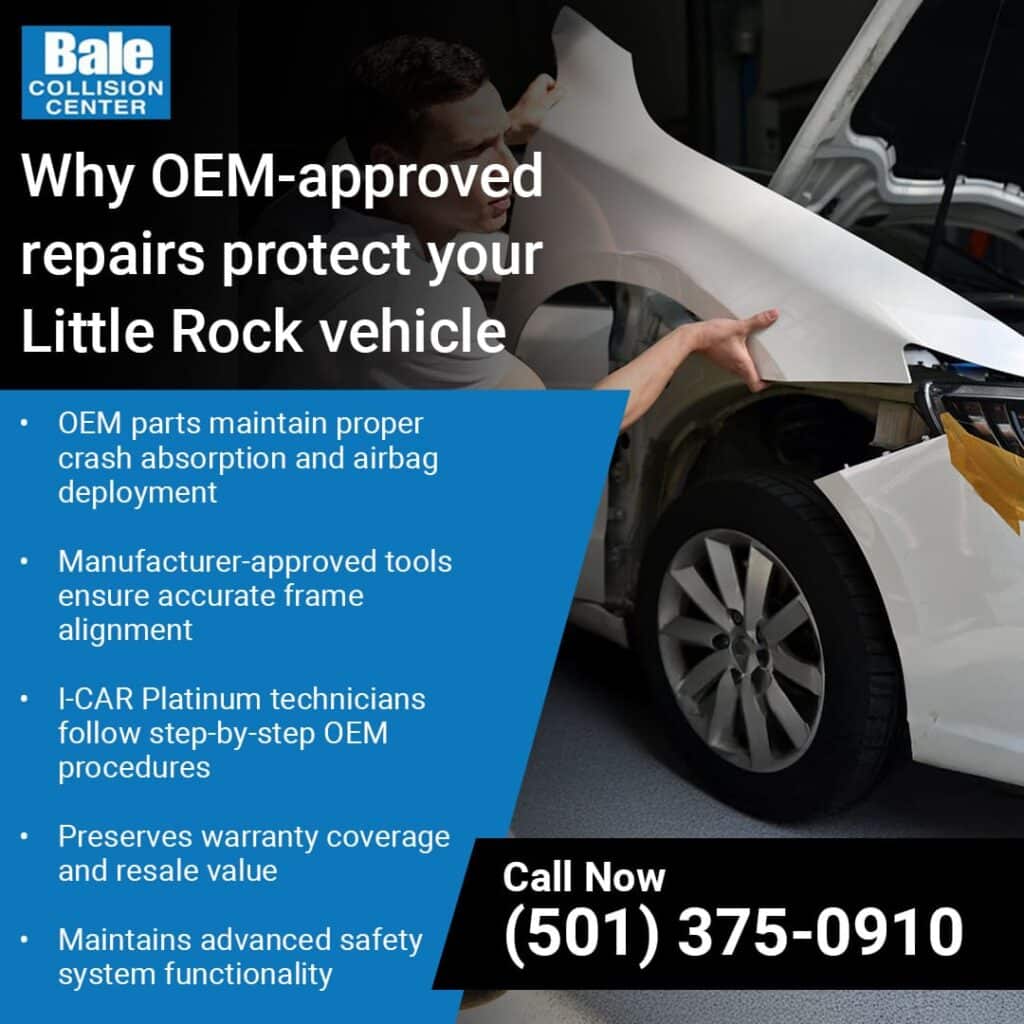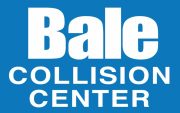When a vehicle is involved in a collision, the visible damage is only part of the concern. What many drivers in Little Rock may not realize is that improper or incomplete repairs can directly affect the safety and performance of their car. Structural misalignment, overlooked safety systems, and the use of non-approved parts all compromise how a vehicle will respond in another accident. For families, commuters, and professionals who rely on their cars every day, repair quality is not just about appearance. It’s also about protecting lives on the road.
Bale Collision Center (Downtown) provides expert auto body repair in Downtown Little Rock, AR, that follows Original Equipment Manufacturer (OEM) standards. By using manufacturer-approved methods, parts, and diagnostic tools, our team restores vehicles to their intended safety specifications. This certified approach reduces the risks tied to substandard repairs, preserves long-term value, and gives car owners the confidence that their vehicle is ready for the road ahead.

What Does OEM-Approved Auto Body Repair Mean?
OEM refers to the Original Equipment Manufacturerthat designed and built your vehicle. These companies issue specifications for every part, component, and repair process to maintain safety and performance.
For example, Toyota publishes repair guidelines that detail exact measurements for frame alignment after a collision. Ford issues standards for welding methods to keep structural integrity intact. General Motors requires approved parts for airbag systems to guarantee proper deployment.
Following OEM in car body repair means technicians rely on these precise instructions rather than shortcuts. Using aftermarket parts or unverified methods may fit a vehicle, but they do not restore the car to the manufacturer’s original safety standards.
OEM-Approved Repair Standards
OEM-approved repair standards are the official instructions set by automakers for restoring vehicles after damage. They cover parts, tools, materials, and step-by-step processes.
For instance, many automakers specify that only OEM bumpers be used because crash testing was conducted with that exact part. Advanced Driver Assistance Systems (ADAS), such as lane departure warnings or adaptive cruise control, also require sensor recalibration using manufacturer-approved diagnostic tools. Even paint application is outlined, with standards for thickness and curing times to prevent premature rust or mismatched finishes.
At Bale Collision Center, we follow these OEM standards in every repair. By doing so, we maintain the vehicle’s crashworthiness, ensure safety systems work correctly, and help drivers protect their car’s long-term value.
Parts and Materials
OEM parts are components made or approved by the vehicle manufacturer. Aftermarket parts are produced by third-party companies and may not match original specifications.
For example, an OEM replacement airbag in a Honda Civic undergoes crash testing to make sure it is deployed correctly. An aftermarket airbag may fit the module, but it has not been tested under the same conditions.
Impact on Vehicle Safety and Longevity
Using OEM parts helps maintain the vehicle’s original safety and performance characteristics. OEM components are engineered to meet manufacturer specifications, ensuring structural integrity in collisions, proper airbag deployment, and correct operation of electronic safety systems such as sensors and advanced driver-assistance systems (ADAS).
Aftermarket parts, on the other hand, may not meet these exact standards. For example, a non-OEM frame rail may not absorb impact as designed, or a third-party sensor may fail to communicate correctly with the vehicle’s safety network. Over time, this can lead to increased wear on connected systems, reduced crash protection, and potentially higher repair costs.
Tools and Procedures
Importance of Manufacturer-Recommended Tools
Manufacturer-recommended tools are essential for accurate and safe vehicle repairs. Specialized alignment systems, calibration devices, and diagnostic equipment allow technicians to restore structural integrity and electronic systems according to manufacturer standards. Using incorrect tools can cause frame misalignment, improper sensor function, and uneven wear.
Precision tools are particularly important for vehicles with advanced safety systems. Proper use of OEM-approved equipment allows all components to function as intended, maintaining safety and reliability.
Step-by-Step Repair Guidelines Issued by Automakers
OEM repair procedures provide detailed, model-specific instructions for each repair. These guidelines cover structural repairs, sensor recalibration, component installation, and final quality checks. Adhering to them restores the vehicle’s factory safety performance and overall handling characteristics.
Following step-by-step OEM procedures helps maintain airbag deployment timing, sensor accuracy, and frame strength. It also supports vehicle longevity, as repairs are completed according to manufacturer-tested specifications, reducing the risk of future failures or uneven wear.
At Bale Collision Center, our technicians follow these manufacturer guidelines and use proper tools to deliver safe, certified auto body repair for every vehicle.
Why OEM-Approved Repairs Are Vital for Vehicle Safety
Structural Integrity
Proper frame alignment directly affects crash protection. The vehicle frame is designed to absorb and distribute impact forces during collisions. Misaligned frames can compromise crumple zones, causing a higher risk of injury to passengers.
Exact factory measurements are necessary for safety. Automakers specify precise tolerances for each frame and structural component. Deviating from these specifications can alter handling, increase wear on suspension parts, and reduce the effectiveness of seat belts and airbags. Following OEM-approved repair standards restores the vehicle’s structural integrity to factory specifications, maintaining crash protection and long-term reliability.
Advanced Safety Systems (ADAS)
ADAS features include lane departure warnings, adaptive cruise control, forward collision alerts, and automatic braking systems. These systems rely on sensors, cameras, and radar devices calibrated to exact factory standards.
Sensor calibration must follow OEM guidelines to function correctly. Misaligned or improperly calibrated sensors can trigger false warnings, fail to detect obstacles, or prevent automatic braking from activating in critical situations. Accurate calibration preserves vehicle safety and protects passengers on the road.
Airbags and Restraints
Repair accuracy directly affects airbag and restraint system performance. Improper repairs can prevent airbags from deploying on time or at the correct force during a collision, increasing the risk of injury.
Shortcuts in car body repair can compromise safety systems. Skipping OEM procedures or using substandard parts may affect seatbelt tensioners, airbag sensors, and mounting points. Correct repair procedures allow all restraint systems to operate as designed.
At Bale Collision Center, we follow OEM-approved repair procedures to maintain structural integrity, calibrate all ADAS sensors, and restore airbags and restraints, ensuring vehicles are safe and fully functional after auto body services.
Certified Repairs vs. OEM Repairs
While both certified repairs and OEM repairs aim for quality, they differ in methods, parts, and adherence to manufacturer standards.
Technician Training and Credentials
Certified auto body repair technicians have completed industry-recognized training programs. Certifications such as I-CAR Gold Class demonstrate that a shop and its staff meet strict standards for collision repair knowledge, safety practices, and proper equipment use.
Training affects repair quality directly. Certified technicians understand frame alignment, sensor recalibration, and paint application techniques. Without proper training, repairs may compromise structural integrity, sensor function, or the vehicle’s overall performance.
OEM Approval and Its Role
OEM-approved repair means that technicians follow manufacturer standards for every step of the process. While certified technicians have the skills to perform quality repairs, OEM-approved procedures ensure that parts, tools, and repair methods match factory specifications exactly.
Combining certification and OEM procedures delivers full safety and performance. Certified technicians performing OEM repairs restore structural integrity, advanced safety systems, and vehicle reliability, which standard or non-OEM repairs may not guarantee.
| Aspect | Certified Repairs | OEM Repairs |
| Definition | Performed by technicians with industry-recognized training and certifications (e.g., I-CAR, ASE). | Follows manufacturer-approved procedures, tools, and parts for each specific vehicle model. |
| Focus | Technician skill, proper techniques, and adherence to industry safety standards. | Compliance with manufacturer specifications to restore structural integrity, safety systems, and electronics. |
| Parts Used | May use OEM or aftermarket parts depending on the shop’s policies. | Requires OEM parts approved by the manufacturer. |
| Outcome | Repairs are performed by trained professionals, but may not fully match factory standards if non-OEM parts are used. | Repairs restore the vehicle to factory specifications, maintaining safety, performance, and warranty compliance. |
| Best Practice | Combines certification with OEM procedures for optimal results. | Maximizes safety and long-term vehicle value when performed by certified technicians. |
At Bale Collision Center, our certified auto body repair team performs OEM-approved repairs to deliver vehicles that meet manufacturer standards and preserve long-term value.
Long-Term Benefits of OEM-Approved Auto Body Services
Protecting Resale Value
OEM-approved repairs help maintain your vehicle’s resale value. Proper repairs using manufacturer-approved parts and procedures assure prospective buyers that the car meets safety and performance standards. It increases buyer confidence. Documentation showing OEM-compliant repairs signals that the vehicle has been properly maintained, which can prevent price reductions and simplify future sales or trade-ins.
Warranty Considerations
Improper car body repairs can void manufacturer warranties. Using non-OEM parts or failing to follow OEM procedures may result in coverage denial for future issues. OEM-approved repairs preserve warranty protections. Following manufacturer guidelines keeps structural components, safety systems, and electronic features under warranty, reducing the risk of costly out-of-pocket repairs.
Peace of Mind for Drivers
OEM-approved repairs provide assurance that your vehicle is safe and reliable. Drivers know that every repair step, from frame alignment to sensor calibration, has been completed according to manufacturer standards, making the vehicle ready for safe operation.
At our auto body shop in Downtown Little Rock, we combine OEM-approved auto body services with certified technician expertise to provide repairs that protect resale value and ensure driver safety.

Finding the Right Auto Body Repair in Downtown Little Rock, AR
Expertise Matters in Auto Body Repair
Expertise is critical for vehicle safety, performance, and long-term value. Proper expertise prevents problems such as misaligned frames, improperly calibrated ADAS sensors, or uneven paint finishes, which can compromise safety, functionality, and resale value. Technicians with certifications like I-CAR Gold Class or ASE training demonstrate the knowledge and precision needed to handle complex repairs on modern vehicles.
At Bale Collision Center, our I-CAR Platinum-certified technicians bring advanced training and expertise to every auto body repair, ensuring precise, OEM-compliant results.
Experience and Track Record
An auto body shop with years of experience repairing vehicles like yours demonstrates reliability and skill. Verified customer reviews and a history of consistent results indicate that the shop can handle complex repairs safely and efficiently.
Bale Collision Center has been serving the community since 1952, building decades of expertise in auto body repair. One satisfied customer (Branson O.) shared: “This place is honestly amazing, great service, great community, and great deals. We sent in my sister‘s car, and they did a great job on the bodywork. Definitely would recommend this place.” This feedback reflects the consistent quality, attentive service, and trust that local drivers experience when choosing Bale Collision Center for auto body repair in Downtown, Little Rock, AR.
Bale Collision Center: Restoring Your Vehicle Safely and Reliably
Repairs that follow manufacturer standards preserve structural integrity, allow airbags and advanced safety systems to function correctly, and maintain warranty protections. Choosing a trusted, certified auto body shop safeguards your investment.
At Bale Collision Center, we deliver certified, OEM-approved auto body services, restoring vehicles safely and efficiently while protecting their value and ensuring driver confidence on the road. Our experienced team is here to handle collision repairs, paint services, and advanced safety system calibration with precision. Call us today at (501) 375-0910or email bccdowntown@baleautomotive.comto schedule your estimate and get your vehicle back on the road with confidence.
